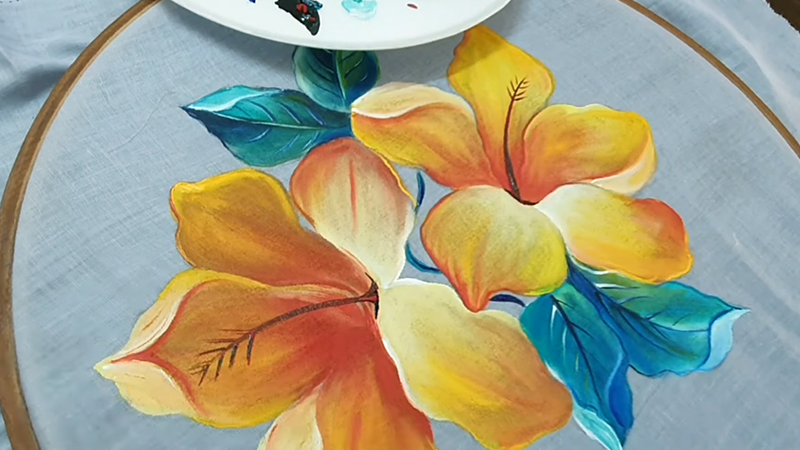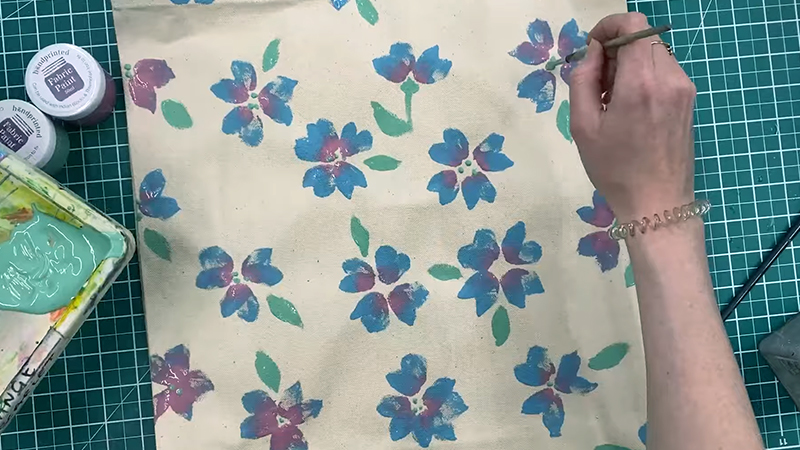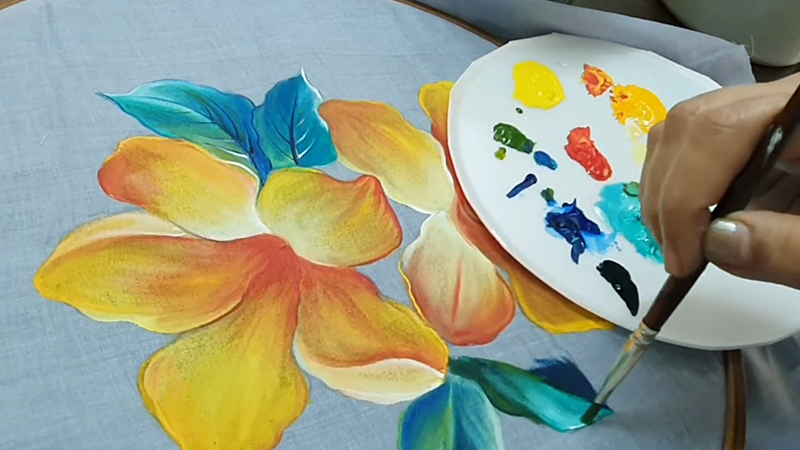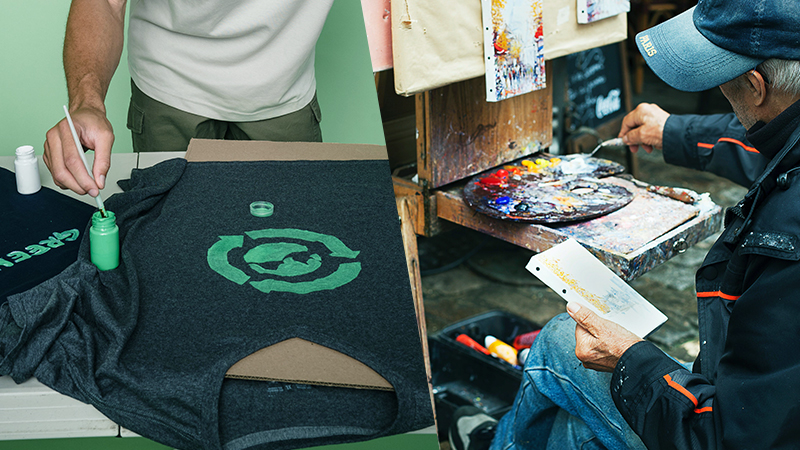Fabric paint, renowned for its versatility in textiles, presents an intriguing prospect for canvas artistry. The question arises: can this specialized medium find a seamless application on the sturdy, woven surface of canvas?
The answer is an unequivocal ‘yes’. Fabric paint, specially formulated to bond with textiles, including cotton canvases, offers a unique creative avenue.
Its attributes, from vibrant color retention to washability and flexible adhesion, make it a compelling choice for artists seeking to infuse canvas with vivid, dynamic designs.
This exploration delves into the nuances of utilizing fabric paint on canvas, uncovering its potential to unlock a new realm of artistic expression.

What Is Fabric Paint on Canvas?
Fabric paint on canvas is a specialized type of paint designed for textiles, including canvas material. Unlike traditional acrylic or oil paints, fabric paint is formulated to adhere to fabrics effectively.
When applied to canvas, it creates a lasting bond due to the material’s slightly porous texture. This type of paint offers vibrant and intense colors, resulting in visually striking artwork.
It is known for its flexibility, allowing the painted canvas to be stretched or rolled without cracking or flaking. Fabric paint can be applied using various techniques, including brushing, sponging, stamping, and spraying.
It also provides the option for texture and finish variations, depending on the type of fabric paint used. Additionally, fabric paint on canvas can be heat-set for durability, making it suitable for washable creations.
Can You Use Fabric Paint on Canvas?
Yes, you can use fabric paint on canvas, but there are a few things to remember. Fabric paint is specially formulated to adhere to textiles with fibers that absorb the paint.
While not a traditional fabric, canvas has a woven texture that can absorb paint to some extent.
This makes it possible to use fabric paint on canvas, although there are a few considerations:
Preparation
Adequately preparing the surface is crucial before applying fabric paint to the canvas. Begin by cleaning the canvas to remove any dust or debris.
Next, apply a thin layer of gesso, a paint primer specifically designed for use on canvas. Gesso helps create a smoother and more receptive surface for the fabric paint to adhere to.
Texture and Absorbency
It’s important to acknowledge that canvas, though not a traditional fabric, possesses a distinct woven texture.
This texture can influence how the fabric paint interacts with the surface. Conducting a small test patch is advisable to gauge how the paint will be absorbed and to get a sense of the final result.
Flexibility
Unlike clothing or textiles that experience various degrees of movement and stretching, canvas is typically stretched over a frame and remains relatively stationary.
Consequently, the fabric paint does not need to be as flexible. This allows for a broader range of fabric paint options on canvas.
Fixative
Once the fabric paint has dried, applying a fabric fixative or sealant is recommended. This additional step helps set the paint, preventing it from flaking or rubbing off over time. The fixative acts as a protective layer, ensuring the longevity of your artwork.
Washability
While canvas artwork isn’t subjected to regular washing like clothing, there may be instances where it needs to be cleaned.
If you foresee this, choosing fabric paint labeled as washable is crucial. This ensures the paint remains vibrant and intact even after a gentle wash.
Heat Setting
Some fabric paints necessitate heat-setting to ensure longevity. This process is typically achieved by carefully ironing the painted area with a pressing cloth.
Following the manufacturer’s instructions regarding heat-setting is crucial for achieving the best results.
Layering
When applying multiple layers of fabric paint, allowing each layer to dry thoroughly before adding the next is imperative. This precaution prevents colors from mixing or smudging, ensuring a clean and vibrant result.
Brushes and Application
Opt for high-quality brushes designed explicitly for fabric painting. The right brushes will help you achieve precise and consistent application.
Be mindful of your brush strokes, as they can affect the final texture and appearance of the paint on the canvas.
Drying Time
Fabric paint generally takes longer to dry compared to acrylics or other paints. Patience is key.
Allow each layer to air dry, or use a fan to expedite the process. Rushing this step can lead to uneven application and compromise the outcome.
Application Techniques for Fabric Paint on Canvas

When using fabric paint on canvas, you can employ various application techniques to achieve different textures, patterns, and effects.
Here are some popular techniques:
Brushing
This is one of the most common methods for applying fabric paint to canvas. You can use various brushes to create different brushstroke effects. Thick brushes can give you bold, textured strokes, while fine brushes can create intricate details.
Sponging
Dabbing a sponge or brush dipped in fabric paint onto the canvas can create a soft, mottled texture. This technique is great for backgrounds or adding depth and dimension to your artwork.
Spraying
Spray bottles or airbrushes can apply fabric paint in a fine mist or a controlled spray pattern. This technique allows for a more even and smooth application of paint. It’s excellent for creating gradients or abstract backgrounds.
Stamping
Fabric paint can be applied to various stamps or printing blocks and pressed onto the canvas. This technique is ideal for creating repeating patterns or adding exciting textures to your artwork.
Stenciling
Using stencils, you can create precise and intricate designs on your canvas. Place the stencil on the canvas and apply fabric paint over it using a sponge, brush, or airbrush. Lift the stencil carefully to reveal the design.
Finger-Painting
Sometimes, the most personal and expressive touch comes from using your fingers. You can blend and mix colors directly on the canvas and create unique textures and patterns with your hands.
Drip Painting
For a dynamic and abstract effect, thin fabric paint with water and let it drip or pour onto the canvas. Tilt the canvas to guide the flow of the paint, creating interesting shapes and patterns.
Layering
Apply fabric paint in layers to achieve depth and dimension in your artwork. Allow each layer to dry before adding another to prevent colors from mixing too much.
Texturing
You can add texture to your canvas by mixing fabric paint with various mediums like fabric medium, acrylic gel, or modeling paste. These mixtures can be applied with brushes or palette knives to create raised and textured surfaces.
Heat-Setting
After your fabric paint has dried, heat-setting is essential to ensure the paint adheres permanently to the canvas. Follow the manufacturer’s instructions for heat-setting, which usually involves using an iron (without steam) over a protective cloth.
Blending and Mixing
Fabric paint can be blended on the canvas to create smooth color transitions. You can use a brush, sponge, or finger to achieve the desired blending effect.
Tape and Masking
Mask off areas of the canvas with painter’s tape or masking tape before applying fabric paint. Remove the tape once the paint is dry to reveal clean, sharp edges and patterns.
Benefits of Using Fabric Paint on Canvas

Using fabric paint on canvas offers several benefits that can enhance your artistic experience and the quality of your artwork:
Adhesion to Canvas
Fabric paint is specially formulated to create a strong bond with textiles, including canvas. This ensures that your artwork remains securely attached to the canvas surface.
The paint fibers penetrate the canvas, creating a lasting connection that won’t easily peel or crack over time. This adhesion is particularly crucial for artworks that may experience movement or stretching.
Flexibility
Canvas is known for its flexibility, and fabric paint complements this property perfectly.
The paint moves with the canvas, ensuring it retains its integrity even when the fabric is bent, stretched, or rolled. This flexibility makes fabric paint an excellent choice for creating dynamic and versatile artwork.
Vibrant Colors
Fabric paints are renowned for their vivid and intense colors. When applied to canvas, they maintain their brilliance, allowing you to create artwork that commands attention.
The pigments in fabric paint are specially formulated to retain their vibrancy, resulting in visually striking and captivating pieces.
Texture and Finish Options
Fabric paints come in various formulations, including puffy, metallic, and glitter varieties. These options allow artists to experiment with different textures and finishes, adding depth and visual interest to their creations.
Whether you want a raised, three-dimensional effect or a shimmering, metallic finish, fabric paint provides the tools to achieve your desired look.
Washability
Once fabric paint is heat-set, it becomes washable. This means that your canvas artwork can be cleaned if necessary without worrying about the paint coming off.
This feature is precious for artworks displayed in high-traffic areas or for projects involving wearable items like clothing or accessories.
Customization
Fabric paints can be mixed to create custom colors, providing various artistic possibilities. This allows you to achieve the precise shades and tones you envision for your artwork.
Additionally, you can dilute fabric paint with water to achieve a more translucent effect, giving you even greater control over your color palette.
Versatile Application Techniques
Fabric paint offers a plethora of application techniques to choose from. Whether you prefer brushing for precise details, sponging for a soft, mottled effect, or spraying for a seamless finish, fabric paint accommodates various artistic styles and effects.
This versatility empowers artists to explore various methods and discover their unique creative voice.
No Additional Sealants Required
Once fabric paint is heat-set, it typically does not require an additional sealant or fixative to protect your artwork. This simplifies the finishing process, allowing you to enjoy the completed piece without extra steps or materials.
Fabric Paint vs. Acrylic Paint

Fabric and acrylic paint are versatile mediums used for various art and craft projects, but they have distinct differences and ideal applications.
Here’s a comparison between fabric paint and acrylic paint:
Medium Composition
- Fabric Paint: Fabric paint is specially formulated with ingredients that allow it to adhere to textiles like cotton, canvas, and fabric. It typically contains a fabric medium that helps the paint bond to the fabric fibers.
- Acrylic Paint: Acrylic paint is a general-purpose paint that consists of pigments suspended in an acrylic polymer emulsion. It’s designed for various surfaces, including canvas, paper, wood, and more.
Adhesion
- Fabric Paint: Fabric paint is specifically designed to adhere well to fabrics. It bonds with the textile fibers, ensuring that the paint remains durable and doesn’t crack or flake when the fabric is flexed.
- Acrylic Paint: Acrylic paint can adhere to various surfaces, including canvas. However, on fabrics, it may not comply as securely as fabric paint without using a fabric medium.
Flexibility
- Fabric Paint: Fabric paint remains flexible on textiles, allowing the fabric to be stretched or folded without damaging the paint.
- Acrylic Paint: Acrylic paint is flexible but may become less flexible on fabric over time, leading to cracking or peeling if the fabric is bent or stretched frequently.
Color Vibrancy
- Fabric Paint: Fabric paint is known for its vibrant and intense colors, which tend to remain bright on fabric.
- Acrylic Paint: Acrylic paint also offers vibrant colors, but the color intensity may vary depending on the brand and quality of the paint.
Washability
- Fabric Paint: Fabric paint, once heat-set, is washable. This means painted fabrics can be laundered without the paint coming off.
- Acrylic Paint: Acrylic paint is not inherently washable on fabric, and it may require a fabric medium or textile fixative to make it more durable during washing.
Versatility
Fabric Paint: Primarily designed for textile projects, fabric paint is suitable for clothing, home decor items, and fabric art.
Acrylic Paint: Acrylic paint is versatile and can be used on canvas, paper, wood, ceramics, and more. It’s a go-to medium for canvas paintings.
Application Techniques
- Fabric Paint: Fabric paint can be applied using various techniques, including brushing, sponging, stamping, and stenciling on fabric surfaces.
- Acrylic Paint: Acrylic paint is used for traditional painting techniques, including brushwork, palette knife application, and layering on canvas and other surfaces.
FAQs
Can I use fabric paint on a regular canvas?
Yes, fabric paint can be used on a regular canvas. It adheres well to the canvas fibers, allowing for versatile artistic applications.
Does fabric paint affect the texture of the canvas?
Fabric paint can add texture to the canvas, depending on the fabric paint used. For example, puffy fabric paint creates a raised texture.
Is it necessary to heat-set fabric paint on canvas?
Yes, heat-setting fabric paint is recommended to ensure its permanence on the canvas. This is typically done with an iron (without steam) after the paint has dried.
Can I wash a canvas painted with fabric paint?
Yes, once fabric paint is heat-set, the canvas can be gently washed if necessary. Follow care instructions to maintain the artwork’s longevity.
Are there limitations to using fabric paint on canvas?
While fabric paint works well on canvas, it may not offer the same texture or finish as traditional acrylic or oil paints. Testing on a small area before starting a full artwork is advised.
Wrap Up
The marriage of fabric paint and canvas proves to be a harmonious and creative alliance. Through this exploration, we’ve affirmed that fabric paint is not confined to textiles alone; it also thrives on canvas.
Its ability to adhere securely, retain vibrant colors, offer diverse textures, and remain flexible makes it a compelling choice for artists seeking to push the boundaries of their canvas artistry.
Moreover, the washability and accessibility of fabric paint further enhance its appeal.
The canvas becomes a dynamic canvas for innovation, where fabric paint’s unique attributes empower artists to craft captivating, lasting, and visually striking artworks, showcasing the endless possibilities of this dynamic medium.
Leave a Reply